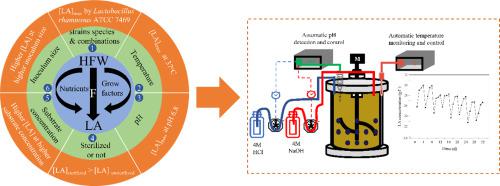Science of the Total Environment ( IF 8.2 ) Pub Date : 2022-06-06 , DOI: 10.1016/j.scitotenv.2022.156479 Liang Song 1 , Shiyu Liu 1 , Rui Liu 1 , Donghai Yang 1 , Xiaohu Dai 1

|
China is vigorously promoting garbage classification, but the treatment of classified waste, especially household food waste (HFW) has yet to be studied. Lactic acid (LA), a high value-added platform molecule has broad market prospects. Although there have been many studies on the production of LA from food waste, open fermentation often produces lots of by-products, while the traditional fermentation under a pure bacteria system often requires the saccharification process, which increases the production cost. We sought to analyze the comprehensive properties of classified HFW in Shanghai, then to produce LA by inoculating lactic acid bacteria (LAB) directly. The effects of strains, temperature, sterilized or not, initial pH, inoculum size, and substrate concentration on LA production were investigated. HFW was rich in nutrients and growth factors which provided the possibility for direct LA production from HFW by inoculating LAB. The results showed that Lactobacillus rhamnosus ATCC 7469, Lactobacillus delbrueckii subsp. bulgaricus and Streptococcus thermophilus all could be used as the inoculum, however, no significant synergistic effect of the three strains on LA production was found. LA concentration of 30.25 g/L at 37 °C, pH 6.8 could be obtained by inoculating Lactobacillus rhamnosus ATCC 7469 from sterilized HFW. High inoculum size and substrate concentration resulted in high LA concentration, but not high LA yield. The result of ANOVA indicated that there was a significantly positive relationship between substrate concentration and LA concentration (r = 0.942, p < 0.01), while no statistically significant difference between these groups at different inoculum size was evident (p = 0.318). In addition, an average LA concentration of 26.8 g/L, LA yield of 0.20 g/g TCOD was obtained by repeated batch fermentation for 32 d.















































 京公网安备 11010802027423号
京公网安备 11010802027423号